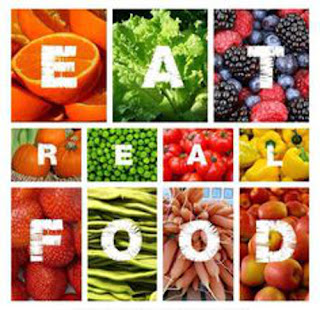How Fiber Helps You Lose Weight
By Cassandra Forsythe-Pribanic, PhD, RD
Some people have a love-hate relationship with fiber.
On one hand, you love it because it really fills you up because it’s either really bulky when you eat it (like bran and beans – insoluble fiber) or it expands and fills your stomach once consumed (like psyllium and flaxseeds – soluble fiber).
On the other hand you may hate it if you don’t eat fiber very often (you give your broccoli to the dog at dinner), and it might make you gassy and uncomfortable.
The good news is that you can get used to eating fiber, and won’t suffer from the bloating side effects.
Fiber is non-digestible, meaning it has virtually no calories when you eat it. Also, it's essential for good health.
There are two basic kinds of fiber: Soluble and Insoluble - You need both.
As the name suggests, the soluble kind partially dissolves, forming a gel.
The insoluble kind, found in bran, nuts and vegetables, is what "keeps you regular." In addition, it sweeps through the colon, pushing out particles that can otherwise lodge in little bulges in the wall and cause diverticulitis.
The soluble kind, found in oats, legumes, fruits and barley, helps lower blood pressure, cholesterol and glucose levels. It lowers glucose levels by slowing the body's absorption of sugar, and consequently can help lower your risk of developing Type 2 diabetes.
Studies show that soluble fiber also appears to substantially lower the risk of heart disease, according to the Harvard School of Public Health, especially those found in [real] whole grains like barley (not pulverized grains found in whole grain bread…) .
According to the Mayo Clinic, men 50 and younger should eat about 38 grams of fiber a day; older men should eat at least 30 grams. Women younger than 50 should eat 25 grams of fiber a day; older women, 21 grams.
In order to get this amount of fiber in your diet, incorporate whole-food fiber sources as often as you can. But, to start out, do not make your next meal a giant serving of beans. Change your diet slowly over a couple of weeks. And drink plenty of fluids. If you have issues still, you can take a food enzyme to help you break down fiber, like Beano.
Due to the satiating and filling effects of fiber, it’s great for weight loss and maintaining a healthy body weight.
Since it basically has no calories (because it’s indigestible), fiber can help make you feel full without adding extra energy you don’t need.
It also sustains healthy blood sugar levels during a meal (by slowing the absorption of carbohydrate sugars in your diet), which keeps you from having blood sugar highs and lows that will make you feel hungry even when you just recently ate.
Also, even more importantly, fiber when combined with protein can greatly assist in weight loss efforts and improve overall health as described in the following research investigation:
• 89 Overweight women were given a high fiber (>35 per day) and high protein (30% dietary energy) diet for 10 weeks without restriction of energy intake. Compared to a diet higher in carbohydrate and low in fat, this high fiber, high protein diet helped women lose more body weight, more total fat, and more belly fat than the standard high carb, low fat diet. Total cholesterol and LDL (bad) cholesterol were also significantly lowered (Morenga, LT et al, 2010).
And, to make fiber even more attractive, a very recent study by National Cancer Institute researchers found that there was a lower risk of dying from cancer in men and women who consumed a high fiber diet – men who ate at least 30 grams of fiber per day and women who had at least 25 grams had a 22% lower risk of dying from cancer than those who ate only 12 and 10 grams respectively (Park Y et al, 2011).
Overall, fiber in foods is one of your best weight-loss allies along with high protein foods and plenty of real, unprocessed foods and beverages. It can also greatly reduce your risk of dying from cancer.
To help you get enough fiber in your diet, choose foods rich in fiber like beans, fruit and vegetables, and look for new functional foods on the market (a food that provides health benefits beyond basic nutrition) that have added specialty fibers and even more filling power.
A Sneaky New Way To Get More Fiber Into Your Fat Fighting Nutrition Plan
Mark Dilworth, BA, PES
Some people have a love-hate relationship with fiber.
On one hand, you love it because it really fills you up because it’s either really bulky when you eat it (like bran and beans – insoluble fiber) or it expands and fills your stomach once consumed (like psyllium and flaxseeds – soluble fiber).
On the other hand you may hate it if you don’t eat fiber very often (you give your broccoli to the dog at dinner), and it might make you gassy and uncomfortable.
The good news is that you can get used to eating fiber, and won’t suffer from the bloating side effects.
Fiber is non-digestible, meaning it has virtually no calories when you eat it. Also, it's essential for good health.
There are two basic kinds of fiber: Soluble and Insoluble - You need both.
As the name suggests, the soluble kind partially dissolves, forming a gel.
The insoluble kind, found in bran, nuts and vegetables, is what "keeps you regular." In addition, it sweeps through the colon, pushing out particles that can otherwise lodge in little bulges in the wall and cause diverticulitis.
The soluble kind, found in oats, legumes, fruits and barley, helps lower blood pressure, cholesterol and glucose levels. It lowers glucose levels by slowing the body's absorption of sugar, and consequently can help lower your risk of developing Type 2 diabetes.
Studies show that soluble fiber also appears to substantially lower the risk of heart disease, according to the Harvard School of Public Health, especially those found in [real] whole grains like barley (not pulverized grains found in whole grain bread…) .
According to the Mayo Clinic, men 50 and younger should eat about 38 grams of fiber a day; older men should eat at least 30 grams. Women younger than 50 should eat 25 grams of fiber a day; older women, 21 grams.
In order to get this amount of fiber in your diet, incorporate whole-food fiber sources as often as you can. But, to start out, do not make your next meal a giant serving of beans. Change your diet slowly over a couple of weeks. And drink plenty of fluids. If you have issues still, you can take a food enzyme to help you break down fiber, like Beano.
Due to the satiating and filling effects of fiber, it’s great for weight loss and maintaining a healthy body weight.
Since it basically has no calories (because it’s indigestible), fiber can help make you feel full without adding extra energy you don’t need.
It also sustains healthy blood sugar levels during a meal (by slowing the absorption of carbohydrate sugars in your diet), which keeps you from having blood sugar highs and lows that will make you feel hungry even when you just recently ate.
Also, even more importantly, fiber when combined with protein can greatly assist in weight loss efforts and improve overall health as described in the following research investigation:
• 89 Overweight women were given a high fiber (>35 per day) and high protein (30% dietary energy) diet for 10 weeks without restriction of energy intake. Compared to a diet higher in carbohydrate and low in fat, this high fiber, high protein diet helped women lose more body weight, more total fat, and more belly fat than the standard high carb, low fat diet. Total cholesterol and LDL (bad) cholesterol were also significantly lowered (Morenga, LT et al, 2010).
And, to make fiber even more attractive, a very recent study by National Cancer Institute researchers found that there was a lower risk of dying from cancer in men and women who consumed a high fiber diet – men who ate at least 30 grams of fiber per day and women who had at least 25 grams had a 22% lower risk of dying from cancer than those who ate only 12 and 10 grams respectively (Park Y et al, 2011).
Overall, fiber in foods is one of your best weight-loss allies along with high protein foods and plenty of real, unprocessed foods and beverages. It can also greatly reduce your risk of dying from cancer.
To help you get enough fiber in your diet, choose foods rich in fiber like beans, fruit and vegetables, and look for new functional foods on the market (a food that provides health benefits beyond basic nutrition) that have added specialty fibers and even more filling power.
A Sneaky New Way To Get More Fiber Into Your Fat Fighting Nutrition Plan
Mark Dilworth, BA, PES







Comments
Post a Comment